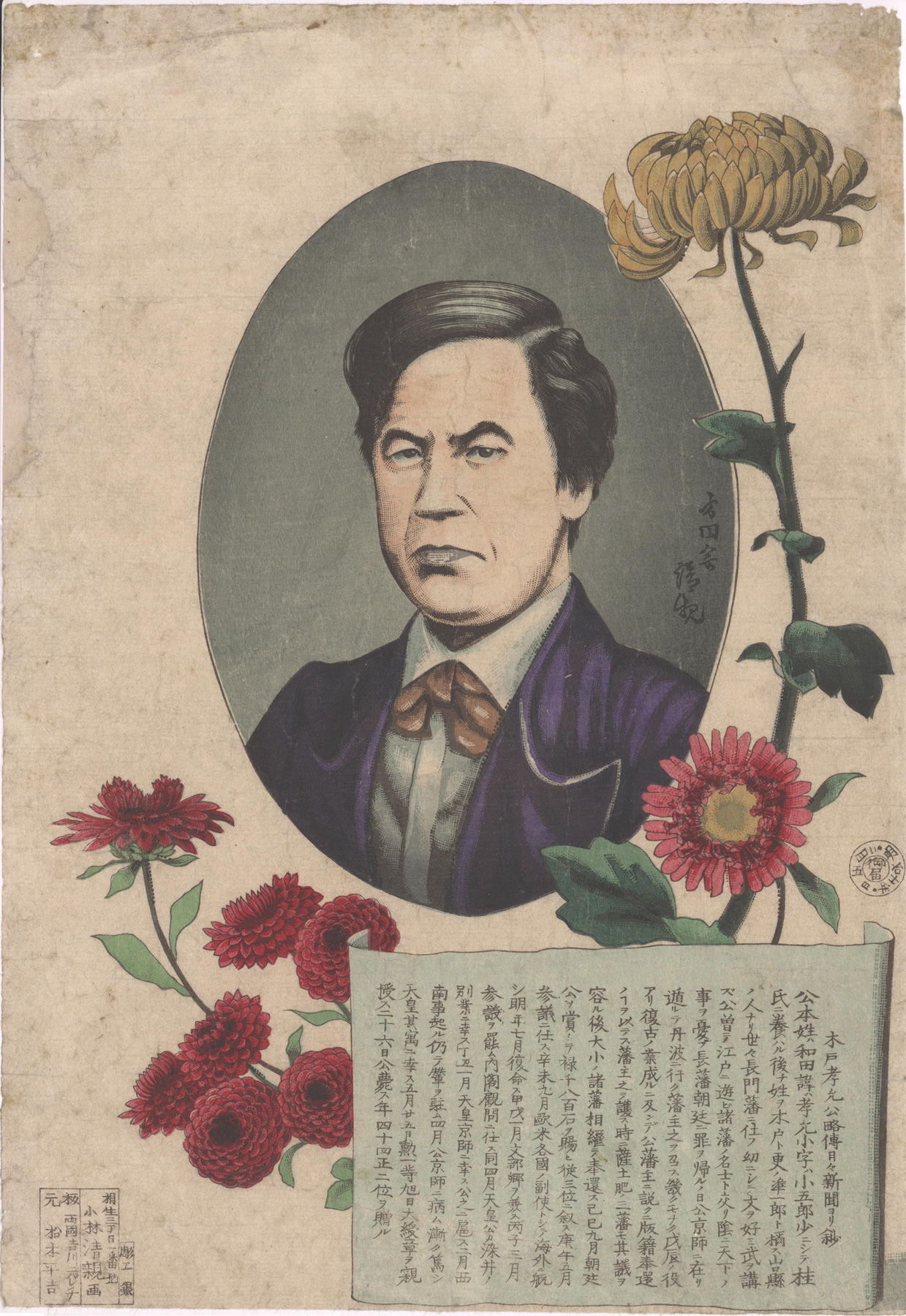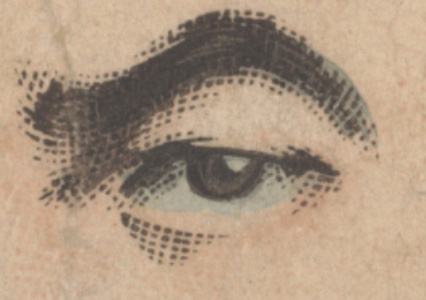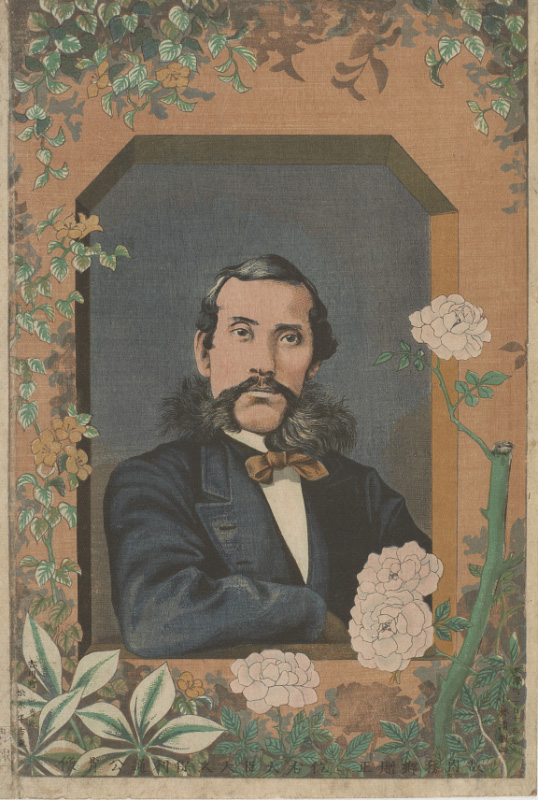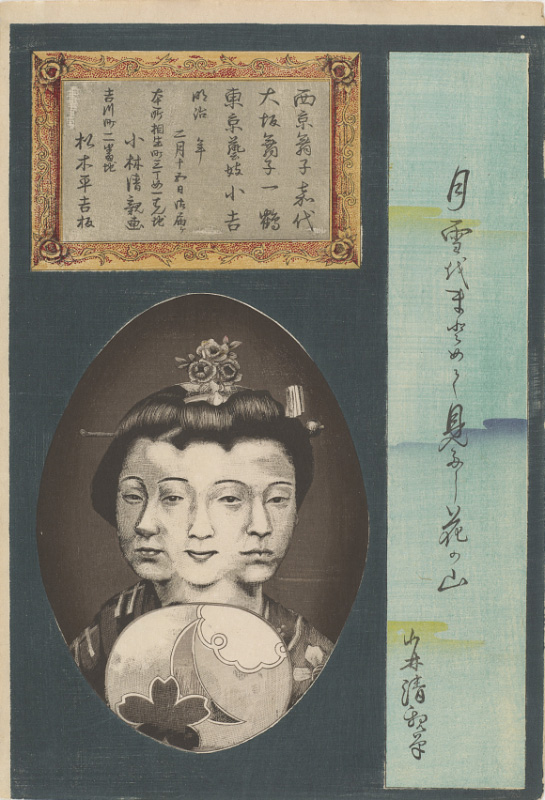About This Print
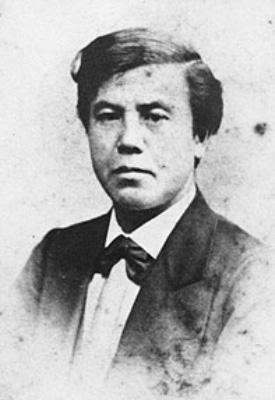 | 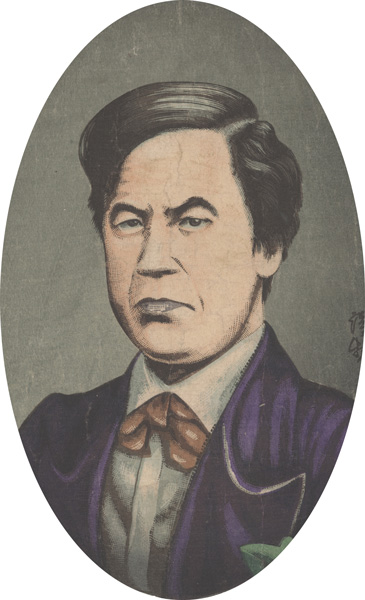 detail from this collection's print detail from this collection's print | 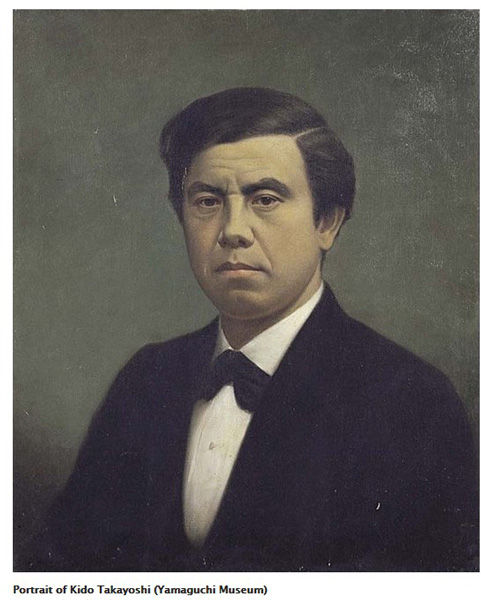 |
Kiyochika’s earliest known print of an individual was aportrait of Saigō Takamori, published by Matsuki on October 5, 1877, justeleven days after the death of the popular leader of the Satsuma Rebellion. It is a wholly traditionalprint that shows Saigō seated in a chair, his face depicted in an imaginaryconception made familiar in countless prints of the rebellion over thepreceding months. It was not untilFebruary 1878 that Kiyochika turned to a completely new style in a memorialportrait of Kido Kōin, another important early Meiji leader, who had died oftuberculosis in May 1877. The portraitwas framed in the oval shape frequently used for photographs at the time, andseems clearly to have been modeled after a surviving photograph of Kido.
Just ten days after the portrait of Kido, on February 15,1878, Matsuki published a still more striking portrait by Kiyochika. ThreeGeisha: Kayo of Kyoto, Hitotsuru of Osaka, and Kokichi of Tokyo. The theme of “Beauties of the Three Capitals”(santo bijin) dated back over twocenturies in ukiyo-e, but here Kiyochika has used the novel trick ofoverlapping eyes to combine all three into a single oval portrait. The source of this device is unclear, butKiyochika has executed it skillfully, so that each face may be readseparately. The photographic sense isemphasized by the printing in plain black and by the use of a net pattern in imitationof wood engraving, at that time the primary technique in the West for the massreproduction of photographs.
It was probably later in 1878 that Kiyochika designed Portrait of the Late Home Minister, Lord ŌkuboToshimichi, Awarded Senior Second Rank, Great Minister of the Right. Ōkubowas assassinated in May of that year, the last of the great early Meijitriumvirate after Kido and Saigō. Theimage of the bust is modeled after a photograph of Ōkubo taken in about 1870….
Although considerable care obviously went into the portraitof Ōkubo, it sold so poorly that Matsuki was forced to lower the price from2.5 sen to 2 sen, and then to 1.8 sen – and even then had many left unsold.2
A Short Bio of Kido Takayoshi
Statesman. Born in Yamaguchi, the son of a doctor serving inthe Hagi Clan. He became a pupil of Shoin Yoshida. Later he learnedswordsmanship and western military science in Edo. Opposed to the kobu gattai group (supporters ofthe union of the Imperial Court and the Shogunate), he worked tirelessly forthe sonno joi undo (movement to reverethe emperor and expel the barbarians). He held an important position in theclan and led the argument for the overthrow of the shogunate. In 1866, heconcluded the Satsuma-Choshu Alliance with the Kagoshima Clan. After the coupd'etat of osei fukko (restoration of Imperialrule), he engaged in the drafting of the Charter Oath. Appointed san'yo (senior councillor), hepoured his efforts into hanseki hokan(the return of the lands and people to the Emperor). He became sangi (councilor) in 1870. In 1871,he took part in Iwakura Mission as deputy envoy. Later, he held important postsincluding monbukyo (Education Minister), naimukyo (Home Miinister), chairmanof the local official council, cabinet councilor, etc., while advocating thegradual establishment of constitutional government.
This installation features more than 30 loans from two remarkably rich local resources, the Lavenberg Collection of Japanese Prints, and the Lee & Mary Jean Michels Collection. It was co-curated by Professors Akiko Walley (History of Art and Architecture) and Glynne Walley (East Asian Languages and Literatures) and JSMA Chief Curator Anne Rose Kitagawa. QR codes on selected labels allow visitors to access translations and explanations of the complex wordplay, imagery, and cultural context of these fascinating objects.
KOBAYASHI Kiyochika (小林清親, 1847-1915)
Japanese; Meiji period, 1897
Memorial Portrait of Kido Takayoshi with a“Transcript of the Biographical Sketch of Lord Kido Takayoshi from TheDay-by-Day News” (Kido Takayoshi-kōryakuden Nichi Nichi Shinbun yori shō)
Ukiyo-e woodblock print in vertical ōban format; ink and color on paper
The Lavenberg Collection of Japanese Prints,IHL.1208
This installation features more than 30 loans from two remarkably rich local resources, the Lavenberg Collection of Japanese Prints, and the Lee & Mary Jean Michels Collection. It was co-curated by Professors Akiko Walley (History of Art and Architecture) and Glynne Walley (East Asian Languages and Literatures) and JSMA Chief Curator Anne Rose Kitagawa. QR codes on selected labels allow visitors to access translations and explanations of the complex wordplay, imagery, and cultural context of these fascinating objects.
KOBAYASHI Kiyochika (小林清親, 1847-1915)
Japanese; Meiji period, 1897
Memorial Portrait of Kido Takayoshi with a“Transcript of the Biographical Sketch of Lord Kido Takayoshi from TheDay-by-Day News” (Kido Takayoshi-kōryakuden Nichi Nichi Shinbun yori shō)
Ukiyo-e woodblock print in vertical ōban format; ink and color on paper
The Lavenberg Collection of Japanese Prints,IHL.1208
Born as ason of a low-ranking samurai official in the Tokugawa government, Kobayashi Kiyochika(1847-1915) had a tumultuous youth, fighting for the losing side. Afterlearning how to draw in his late twenties, he reinvented himself as a starMeiji modern print designer. This memorial portrait of one of the “three heroesof the Meiji Restoration” meticulously reproduces an 1872 photograph of KidoTakayoshi (1883-1877) using cutting-edge woodblock-printmaking techniquesdeveloped to imitate new Western modes of reproduction, namely intaglio andlithography. The innovation of this new style is obvious when compared with thetreatment of the portraits of Kabuki actor Ichikawa Danjūrō VIII (1823-1854,elsewhere in this gallery) and of heroic rebel samurai Saigō Takamori(1828-1877, in the adjacent gallery).
Print Details
| IHL Catalog | #1208 |
| Title or Description | Portrait of Kido Takayoshi (With a transcript of the biographical sketch of Lord Kido Takayoshi from the Nichinichi Shinbun 木戸孝允公略傳日々新聞ヨリ録) |
| Series | |
| Artist | Kiyochika Kobayashi (1847-1915) |
| Signature |  |
| Seal | none |
| Publication Date |  This date seal is sometimes referred to as a "nengō" seal. |
| Publisher | 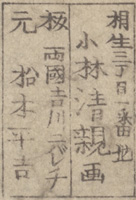 (firm name Daikokuya Heikichi 大黒屋平吉) [Marks pub. ref. 029; seal not shown] |
| Carver |  Horikō Gin 彫工銀 Horikō Gin 彫工銀 |
| Impression | excellent |
| Colors | excellent |
| Condition | fair - soiling; paper loss along margins; wrinkling; tape remnants verso along top margin; not backed |
| Genre | ukiyo-e; nizura |
| Miscellaneous | |
| Format | oban |
| H x W Paper | 14 x 9 5/8 in. (35.6 x 24.4 cm) |
| Literature | Kiyochika: Artist of Meiji Japan, Henry D. Smith II, Santa Barbara Museum of Art, 1988, p. 28-29 (described in text, but not pictured) |
| Collections This Print |


